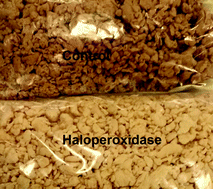Enzymatic delignification and hexenuronic acid removal in cellulosic papermaking pulp using a haloperoxidase
Abstract
A novel approach for lignin and hexenuronic acid (HexA) removal from cellulosic pulp based on the combination of a vanadium haloperoxidase (Hap) and the tertiary amine 1,4-diazabicyclo[2.2.2]octane (DABCO) as a co-catalyst was tested on oxygen-delignified kraft pulp. It was found that the addition of DABCO, likely through the formation of a reactive quaternary chlorammonium cation, consistently led to an unprecedentedly high lignin removal, HexA reduction and brightness gain in a one-stage enzymatic treatment. Under buffered conditions at pH 4.5 and 60 °C at 10% dry matter, using NaCl as an electron donor and H2O2 as an electron acceptor and DABCO as a co-catalyst, high selectivity was achieved, leading to a considerable brightness gain and more than 80% of HexA removal without observing a reduction in the average degree of polymerization of cellulose. The treatment also showed superior HexA removal and selectivity compared to a conventional treatment based on hot acid hydrolysis (A-stage) when applied in a standard bleaching sequence. It was found important to control the pH in the Hap + DABCO stage, as under non-buffered conditions, the performance was inferior when compared to that of a non-enzymatic HOCl treatment. Hydrogen peroxide was proposed to contribute to the brightening during the Hap + DABCO stage.



 Please wait while we load your content...
Please wait while we load your content...